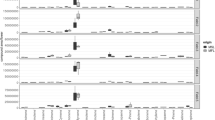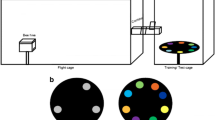Abstract
Foraging bumblebees scent mark flowers with hydrocarbon secretions. Several studies have found these scent marks act as a repellent to bee foragers. This was thought to minimize the risk of visiting recently depleted flowers. Some studies, however, have found a reverse, attractive effect of scent marks left on flowers. Do bees mark flowers with different scents, or could the same scent be interpreted differently depending on the bees’ previous experience with reward levels in flowers? We use a simple experimental design to investigate if the scent marks can become attractive when bees forage on artificial flowers that remain rewarding upon the bees’ return after having depleted them. We contrast this with bees trained in the more natural scenario where revisits to recently emptied flowers are unrewarding. The bees’ association between scent mark and reward value was tested with flowers scent marked from the same source. We find that the bees’ experience with the level of reward determines how the scent mark is interpreted: the same scent can act as both an attractant and a repellent. How experience and learning influence the interpretation of the meaning of chemical signals deposited by animals for communication has rarely been investigated.


Similar content being viewed by others
References
Cameron SA (1981) Chemical signals in bumble bee foraging. Behav Ecol Sociobiol 9:257–260
Chapman RE, Wang J, Bourke AFG (2003) Genetic analysis of spatial foraging patterns and resource sharing in bumble bee pollinators. Mol Ecol 12:2801–2808
Chittka L (1998) Sensorimotor learning in bumblebees: long term retention and reversal training. J Exp Biol 201:515–524
Chittka L, Thomson JD (1997) Sensori-motor learning and its relevance for task specialization in bumble bees. Behav Ecol Sociobiol 41:385–398
Chittka L, Geiger K, Kunze J (1995) Influences of landmark sequences on distance estimation of honeybees. In: Elsner N, Menzel R (eds) Proceedings of the 23rd Goettingen Neurobiology Conference, Thieme, Stuttgart, p 27
Collett TS, Kelber A (1988) The retrieval of visuo-spatial memories by honeybees. J Comp Physiol A 163:145–150
Free JB, Williams IH (1983) Scent-marking of flowers by honeybees. J Apic Res 22:86–90
Gawleta N, Zimmerman Y, Eltz T (2005) Repellent foraging scent recognition across bee families. Apidologie 36:325–330
Giurfa M, Núñez JA (1992) Honeybees mark with scent and reject recently visited flowers. Oecologia 89:113–117
Goulson D, Stout JC, Langley J, Hughes WOH (2000) Identity and function of scent marks deposited by foraging bumblebees. J Chem Ecol 26:2897–2911
Harrington FH (1981) Urine-marking and caching behavior in the wolf. Behaviour 76:280–289
Hartlieb E, Anderson P, Hansson BS (1999) Appetitive learning of odours with different behavioural meaning in moths. Physiol Behav 67:671–677
Henry JD (1977) The use of urine marking in the scavenging behavior of the red fox (Vulpes vuples). Behaviour 61:82–105
Hölldobler B, Wilson EO (1990) The ants. Springer, Berlin Heidelberg New York
Karlson P, Luscher M (1959) ‘Pheromones’: a new term for a class of biologically active substances. Nature 183:55–56
Keeling C, Plettner E, Slessor K (2004) Hymenopteran semiochemicals. Top Curr Chem 239:133–177
Lotto RB, Chittka L (2005) Seeing the light: illumination as a contextual cue to color choice behavior in bumblebees. Proc Natl Acad Sci USA 102:3852–3856
Menzel R (1985) Learning in honey bees in an ecological and behavioral context. In: Hölldobler B, Lindauer M (eds) Experimental behavioral ecology. Gustav Fischer Verlag, Stuttgart, pp 55–74
Pelletier L, McNiel JN (2003) The effect of food supplementation of reproductive success in bumblebee field colonies. Oikos 103:688–694
Reader T, MacLeod I, Elliott PT, Robinson OJ, Manica A (2005) Inter-order interactions between flower-visiting insects: foraging bees avoid flowers previously visited by hoverflies. J Insect Behav 18:51–57
Ribbands CR (1949) The foraging method of individual honey-bees. J Anim Ecol 18:47–66
Sakagami SF, Roubik DW, Zucchi R (1993) Ethology of the robber stingless bee, Lestrimelitta-Limao (Hymenoptera, Apidae). Sociobiology 21:237–277
Saleh N, Ohashi K, Thomson JD, Chittka L (2006) Facultative use of repellent scent mark in foraging bumblebees: complex versus simple flowers. Anim Behav 71:847–854
Sandoz JC, Pham-Delegue MH, Renou M, Wadhams LJ (2001) Asymmetrical generalisation between pheromonal and floral odours in appetitive olfactory conditioning of the honey bee (Apis mellifera L.). J Comp Physiol A Sens Neural Behav Physiol 187:559–568
Schmid-Hempel R, Schmid-Hempel P (1998) Colony performance and immunocompetence of a social insect, Bombus terrestris, in poor and variable environments. Funct Ecol 12:22–30
Schmitt U, Bertsch A (1990) Do foraging bumblebees scent-mark food sources and does it matter? Oecologia 82:137–144
Schmitt U, Lubke G, Francke W (1991) Tarsal secretion marks food sources in bumblebees (Hymenoptera: Apidae). Chemoecology 2:35–40
Seeley TD (1995) The wisdom of the hive: the social physiology of honey bee colonies. Harvard University Press, Cambridge, MA
Stout JC, Goulson D (2001) The use of conspecific and interspecific scent marks by foraging bumblebees and honeybees. Anim Behav 62:183–189
Stout JC, Goulson D (2002) The influence of nectar secretion rates on the responses of bumblebees (Bombus spp.) to previously visited flowers. Behav Ecol Sociobiol 52:239–246
Stout JC, Goulson D, Allen JA (1998) Repellent scent-marking of flowers by a guild of foraging bumblebees (Bombus spp.). Behav Ecol Sociobiol 43:317–326
Thomson JD, Chittka L (2001) Pollinator individuality: when does it matter? In: Chittka L, Thomson JD (eds) Cognitive ecology of pollination. University Press, Cambridge, pp 191–213
Williams CS (1998) The identity of the previous visitor influences flower rejection by nectar-collecting bees. Anim Behav 56:673–681
Williams CS, Poppy GM (1997) Responses of individual honeybees to artificial feeders visited by themselves and to feeders visited by hivemates. J Apic Res 36:105–108
Acknowledgement
This study was funded by a Westfield Trust Research Studentship from Queen Mary College to N.S. Experiments comply with the current laws of the United Kingdom.
Author information
Authors and Affiliations
Corresponding author
Additional information
Communicated by M. Giurfa
Rights and permissions
About this article
Cite this article
Saleh, N., Chittka, L. The importance of experience in the interpretation of conspecific chemical signals. Behav Ecol Sociobiol 61, 215–220 (2006). https://doi.org/10.1007/s00265-006-0252-7
Received:
Revised:
Accepted:
Published:
Issue Date:
DOI: https://doi.org/10.1007/s00265-006-0252-7




